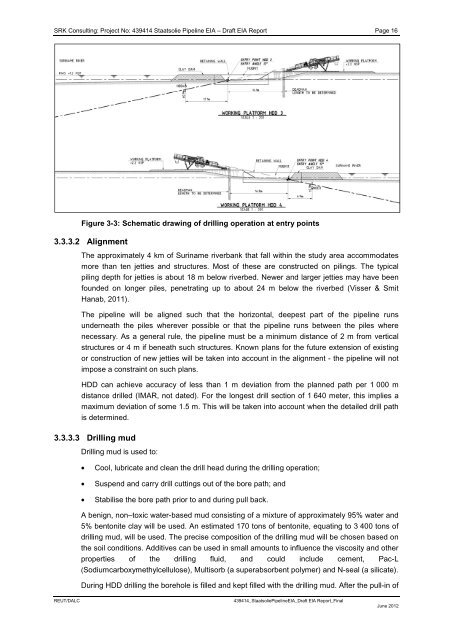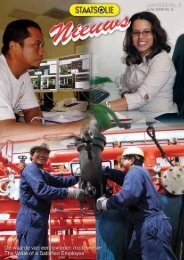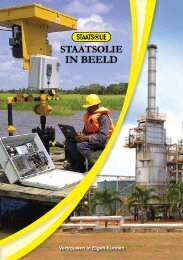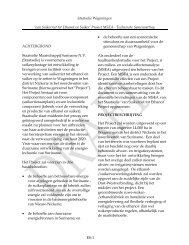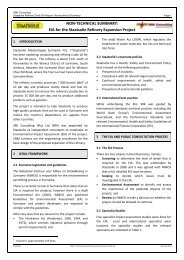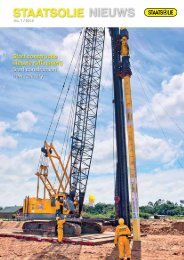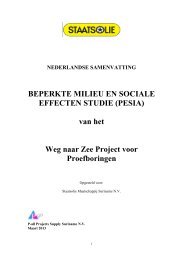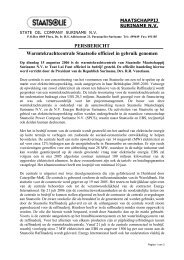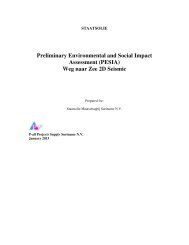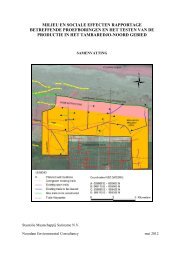concept EIA-rapport - Staatsolie
concept EIA-rapport - Staatsolie
concept EIA-rapport - Staatsolie
Create successful ePaper yourself
Turn your PDF publications into a flip-book with our unique Google optimized e-Paper software.
SRK Consulting: Project No: 439414 <strong>Staatsolie</strong> Pipeline <strong>EIA</strong> – Draft <strong>EIA</strong> Report Page 16<br />
Figure 3-3: Schematic drawing of drilling operation at entry points<br />
3.3.3.2 Alignment<br />
The approximately 4 km of Suriname riverbank that fall within the study area accommodates<br />
more than ten jetties and structures. Most of these are constructed on pilings. The typical<br />
piling depth for jetties is about 18 m below riverbed. Newer and larger jetties may have been<br />
founded on longer piles, penetrating up to about 24 m below the riverbed (Visser & Smit<br />
Hanab, 2011).<br />
The pipeline will be aligned such that the horizontal, deepest part of the pipeline runs<br />
underneath the piles wherever possible or that the pipeline runs between the piles where<br />
necessary. As a general rule, the pipeline must be a minimum distance of 2 m from vertical<br />
structures or 4 m if beneath such structures. Known plans for the future extension of existing<br />
or construction of new jetties will be taken into account in the alignment - the pipeline will not<br />
impose a constraint on such plans.<br />
HDD can achieve accuracy of less than 1 m deviation from the planned path per 1 000 m<br />
distance drilled (IMAR, not dated). For the longest drill section of 1 640 meter, this implies a<br />
maximum deviation of some 1.5 m. This will be taken into account when the detailed drill path<br />
is determined.<br />
3.3.3.3 Drilling mud<br />
Drilling mud is used to:<br />
• Cool, lubricate and clean the drill head during the drilling operation;<br />
• Suspend and carry drill cuttings out of the bore path; and<br />
• Stabilise the bore path prior to and during pull back.<br />
A benign, non–toxic water-based mud consisting of a mixture of approximately 95% water and<br />
5% bentonite clay will be used. An estimated 170 tons of bentonite, equating to 3 400 tons of<br />
drilling mud, will be used. The precise composition of the drilling mud will be chosen based on<br />
the soil conditions. Additives can be used in small amounts to influence the viscosity and other<br />
properties of the drilling fluid, and could include cement, Pac-L<br />
(Sodiumcarboxymethylcellulose), Multisorb (a superabsorbent polymer) and N-seal (a silicate).<br />
During HDD drilling the borehole is filled and kept filled with the drilling mud. After the pull-in of<br />
REUT/DALC 439414_<strong>Staatsolie</strong>Pipeline<strong>EIA</strong>_Draft <strong>EIA</strong> Report_Final<br />
June 2012


